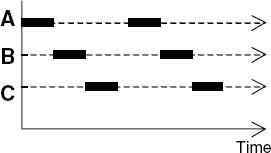Chapter 3. Concurrent Execution
The execution of a concurrent program consists of multiple processes active at the same time. As discussed in the last chapter, each process is the execution of a sequential program. A process progresses by submitting a sequence of instructions to a processor for execution. If the computer has multiple processors then instructions from a number of processes, equal to the number of physical processors, can be executed at the same time. This is sometimes referred to as parallel or real concurrent execution. However, it is usual to have more active processes than processors. In this case, the available processors are switched between processes. Figure 3.1 depicts this switching for the case of a single processor supporting three processes, A, B and C. The solid lines represent instructions from a process being executed on the processor. With a single processor, each process makes progress but, as depicted in Figure 3.1, instructions from only one process at a time can be executed.

Figure 3.1. Process switching.
The switching between processes occurs voluntarily or in response to interrupts. Interrupts signal external events such as the completion of an I/O operation or a clock tick to the processor. As can be seen from Figure 3.1, processor switching does not affect the order of instructions executed by each process. The processor executes a sequence of ...
Get Concurrency: State Models and Java Programs now with the O’Reilly learning platform.
O’Reilly members experience books, live events, courses curated by job role, and more from O’Reilly and nearly 200 top publishers.

